Stormy weather lures me outside
I do love the summer but I really, really love the winter storms. Finding something as exotic as a columbus crab is a rare treat.
Beachcombing in the dark with the wind howling and the waves crashing is exhilarating enough. But the chances of finding something increase it. The excitement of approaching that unfamiliar object, at first just a smudge in the torchlight, is about as exciting as it gets for me. It may not be for everyone. I was showing taxidermic tendencies from the age of 7 and have, if anything, got worse, but I think it is primaeval and there is at least a dram of it in all of us.
Beachcombing our way to world-domination
I have read that we, as a species, may be beachcombers. Our prehistoric dispersal around the coasts of the world makes perfect sense to me. There are strong theories of the Celts or Basque-speaking predecessors migrating from Iberia along the coastline far west of present-day Cornwall. The edge of the sea can be more generous than the land, which requires knowledge, skill or planning to find food. Humans seem to quickly exhaust the land, if we don’t turn to farming. I’m very happy to be a beach-combing species.
The Castaway Columbus Crab and other crustaceans
We have not found one yet this year but, when debris, and especially goose barnacles, wash up, we always have a little look for Columbus crabs (Planes minutus) hiding somewhere..

I first read about the Columbus Crab as the Sargassum Crab, in a book called Underwater Life – Oxford Scientific Films. I was pretty sure that, unless I became a marine biologist, I would never see one myself as they lived afloat in the Sargasso Sea. But let’s back track a bit.
Life afloat
Floating marine debris, mostly wood, but more recently plastic, is a mobile landfall to a number of species. It is an unusual little self contained ecosystem that is on the move. Trees, mountains, open plains and woodland doesn’t move. Seabeds and islands may move through tectonic action but imperceptibly in the life of an animal. The nearest things, of oceanic origin, to this World are perhaps icebergs, pack-ice and the bodies of large whales and sharks. Each of which through cold or adaptation has ways of resisting most passengers.
But… spooning (or spooned by) the gulf stream as it runs up the eastern north American coastline is a gyre. A watery roundabout, driven by the tropical weather (and subsequent evaporation to the south) forming a fabulous mystical paradise called the Sargasso Sea. Which is bounded by currents on all sides rather than land which typifies other ‘seas’. Here, for thousands of years or more, the warm ocean has just gone round and round like a merry-go-round. Creating a safe area for evolution of the kind that we think of on remote islands, rather than in the sea itself. Biologically, it is a sort-of continent. My Phillip’s Atlas of the Oceans says that the centre of the Sargasso Sea may be a metre higher than the surrounding ocean.. a bulge in the sea!
Sargassum
Floating in the sea is an alga called Sargassum. It looks a bit like bladder wrack or serrated wrack but it has no holdfast and simply lives afloat. There in the warm surface waters, many species can nestle amongst its fronds. The perimeter of the Sargasso Sea is where the action happens. Currents turn this world and on them float trees and other debris journeying from distance rivers and beaches. Generally skimming and journeying on, but sometimes getting stuck in the merry-go-round.
No refuge in paradise
The European Eel is one species that successfully punctures the outer skin of the Sargasso sea to breed there. Before its larval babies begin the perilous journey across the Atlantic and back into our rivers. In my lifetime eels were considered one of the commonest fishes, sometimes a nuisance to fishermen. Now these intrepid travellers are one of the most endangered species on the planet.
Voyagers
Although pelagic inhabitants of marine debris date back far beyond our own geological period, it is clear that this wonderful World creates, I presume, the opportunities for species to evolve which can live on floating debris and which, may be unlucky enough to be ship-wrecked on our coasts faraway from the comfortable pelagic home.
Tree-dwelling marine worms?
Sometimes, a piece of wood may bear a hole or two (if it’s not riddled with them) about the diameter of a pencil. A closer look may reveal that the holes are lined with what seems to be a ceramic material. It would be a skilful potter that could line a tunnel in wood with pot and not burn the wood or crack the pot. Splitting the wood may reveal a catacomb of tunnels and, just occasionally the being who made them. Although I have only ever found them in the yuckiest state of decay. These are shipworms (Teredo navalis). They are not worms, but bivalve molluscs. Whose bodies have grown to look like worms whilst their two cockle-like shells have compacted to become effective drill-bits to drive through the wood.
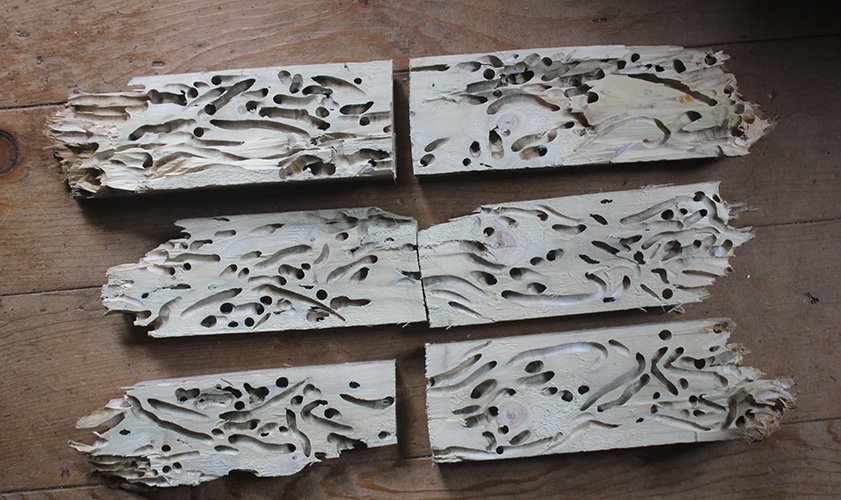
They are marine organisms that have adapted to live in the branches of terrestrial trees which must first fall into the water to make it onto the menu. Normally, considered to be pests of wooden piers and pilings, shipworms were much more of a nuisance to wooden vessels and may have saved our nation and the church of England in 1588.
Protestant shipworms defend Britain?
In my Encyclopaedia of Animal Life, the author Maurice Burton, cites Joseph J. Betz theory that it was Shipworms, more than the superiority of the English fleet, which sank the Spanish Armada. Primed for invasion, the fleet languished for some time in the warm waters of Lisbon Harbour. Betz postulates it may have become riddled with ship worm there, weakening their structures and hulls.
On closer observation
It is always worth giving shipworm wood a good shake or flushing it through with water into a fine net or sieve as the valves or ‘pallets’ are often still in there. As they munch through the wood, shipworms line the burrow they create with a chalky deposit. This must help protect them from predators, prevent partial collapse of their decaying home and perhaps invasion by other shipworms.
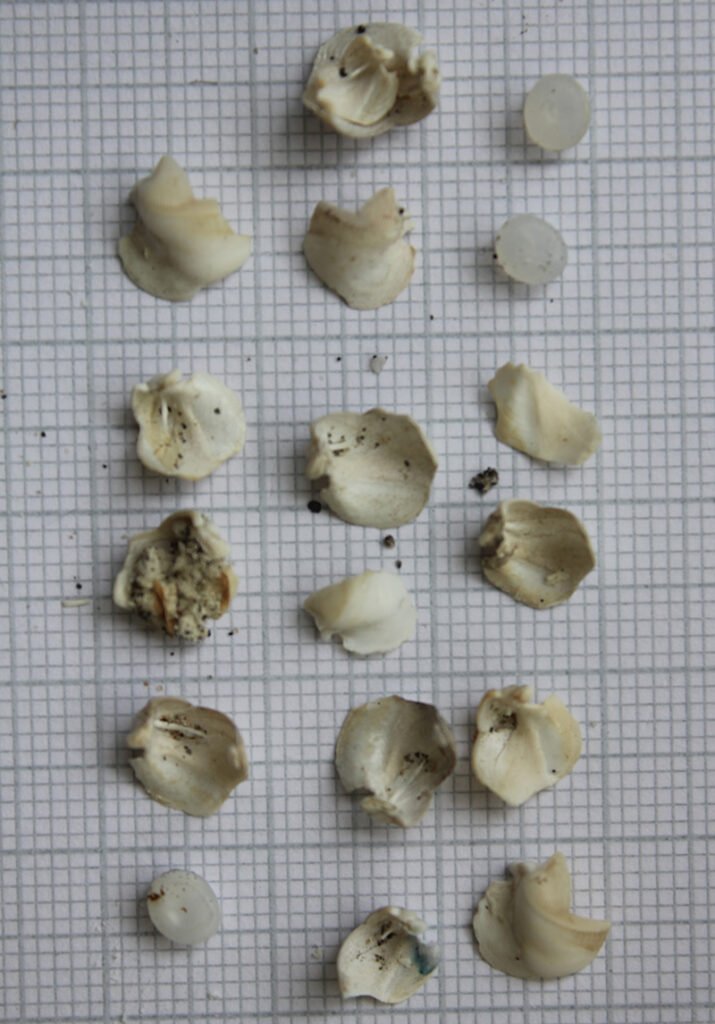
Crustacean frustration
More obvious and often more dynamic is the shipwrecking of sometimes hundreds or even thousands of poor souls who live on the outside surfaces of debris. There are many plants and plant-like animals coating such surfaces that we often pass by without noticing, but goose barnacles catch most people’s attention. They are superficially worm-like, just like the shipworm, but they are not worms. They also look a bit like many fingers reaching through the surface they are on from some alternate universe within; each finger capped with a blade-like thimble. The commonest goose barnacle to wash ashore here is Lepas anatifera. Goose barnacles, like other barnacles, are crustaceans whose relatives are crabs, shrimps, lobsters and woodlice. The wormy-fingery stalk is an extension of the head which sticks very effectively to whatever surface it is on. The thimble is a suit of armour which encloses the rest of the body.
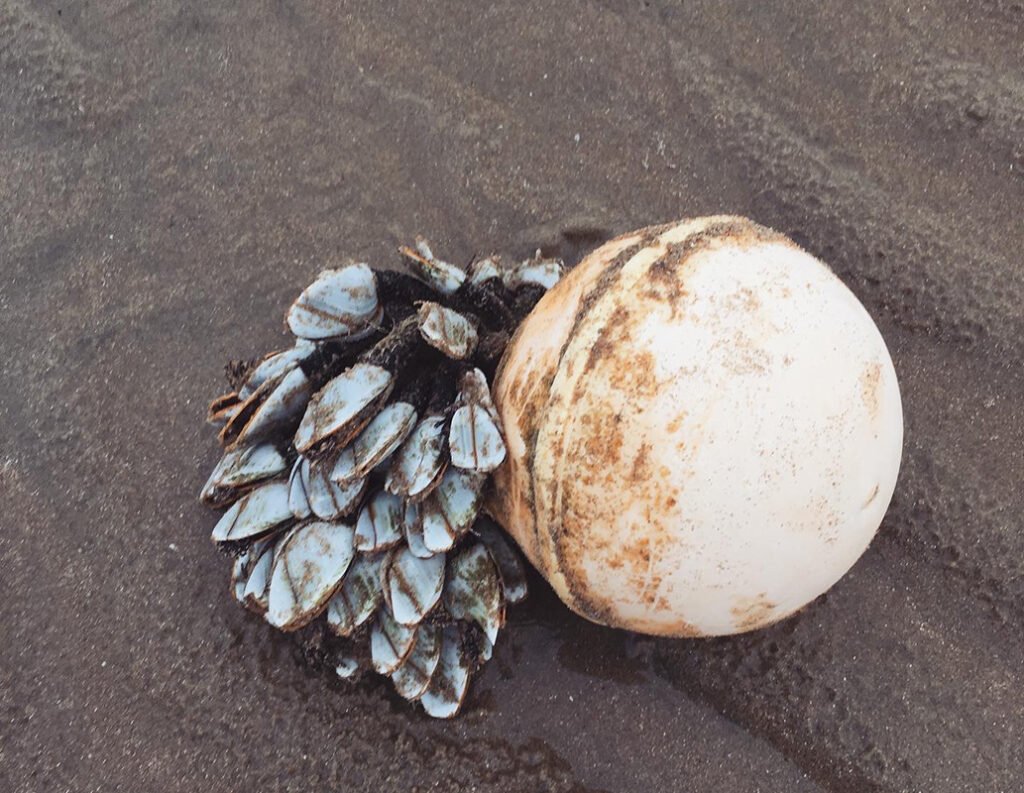
Where goose bumps barnacle
Together, thimble and worm-like finger, look a bit like the head and neck of a goose if you squint really hard and use oodles of imagination. I don’t know whether this led to the common name which later caused some confusion, but it seems that goose barnacles became intertwined, in the mediaeval psyche, with barnacle geese.
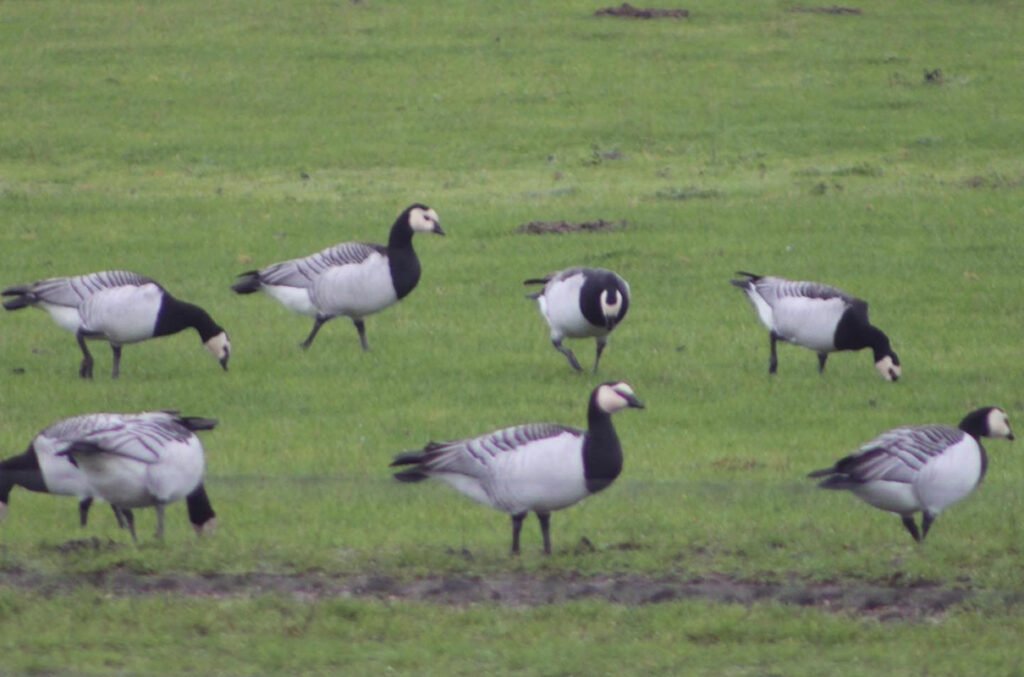
These geese with dark hoods and white faces look a bit like nuns. Irish monks noted that the birds appeared in large numbers, but were never seen to form pairs, make nests, lay eggs or raise chicks. On the same shoreline, bizarre goose barnacles washed ashore which, if opened up, or still alive appeared to have feathery feet inside which do look a bit like embryonic bird parts. This seems to have led them to conclude that the geese laid their eggs on ocean debris, which then grew into the adults. Conveniently, this seems to have led to the conclusion that the geese were not birds but fish and so could be eaten on Fridays. This scholarly science was probably delivered with a nudge and wink and a clink of ale jugs.

So what are barnacles? And how can they be related to crabs?
Charles Darwin made his name as a travelling naturalist. To be taken seriously as a biologist with radical ideas, Darwin felt he must show some expertise. So he set about studying the crustacean class Cirrepedia… barnacles. I think he was fed up of what he called Mr. Balanus by the end of it, but some Barnacles still have the names he gave them, such as: Balanus improvisus which lives in brackish water, Elminius modestus from New Zealand and Acasta spongites which associates with sponges.
There are two main types of barnacle. Firstly the ‘acorn barnacles’ – which comprise many species. These are the familiar limpet-like beings found on seashore rocks. There may be one million per square metre in well populated spots!

The second is the less familiar goose barnacles – also with many species, these barnacles dangle around on an extended stalk. Darwins’ great supporter Thomas Henry Huxley summed up barnacles fairly accurately as animals which
“stood on their heads and kicked food into their mouths”
Thomas Henry Huxley
That’s a barnacle!
The feathery feet inside the barnacle are the thoracic limbs. These feathery feet have the same evolutionary origins as the legs of a lobster, just a slightly different function. They reach out from the thimble (properly called the mantle) and open up like a netted baseball glove. The feet then capture planktonic beings and take them back inside to be swallowed. There is a theatrical or puppet show appearance to this. It is as if the stalk leads to a performer’s body somewhere out of sight.

The barnacles start their lives (after hatching) as shrimplike ‘planktonites’. These free floating beings find desirable residencies and glue their heads to them for ever more. Together they produce forests or perhaps crowds of ship mates who, ship-wrecked together on the shore with their pink bodies flopping about and their feathery fingers grasping at nothing, look a pitiful sight. I rummage through the doomed souls to look for my little stowaway which brings us back to Columbus.
Christopher’s Crab
The Columbus Crab is sometimes called the gulf weed crab (as well as Sargasso crab). I thought it was called the Columbus Crab because of its tendency to cross the Atlantic. Online sources state that a crab was found in the Sargasso Sea by Christopher Columbus’ historic 1492 voyage to the Americas. Having ploughed into the tranquil Sargasso sea full of its floating debris, Columbus is said to have declared that the living crab was a sure sign that land was ahead of them. The record apparently states that the Admiral kept the crab. Who knows, perhaps his crew were getting a bit edgy about his obsessive charge to the edge of the world. Maybe the crab gave them the assurance he needed to carry on.
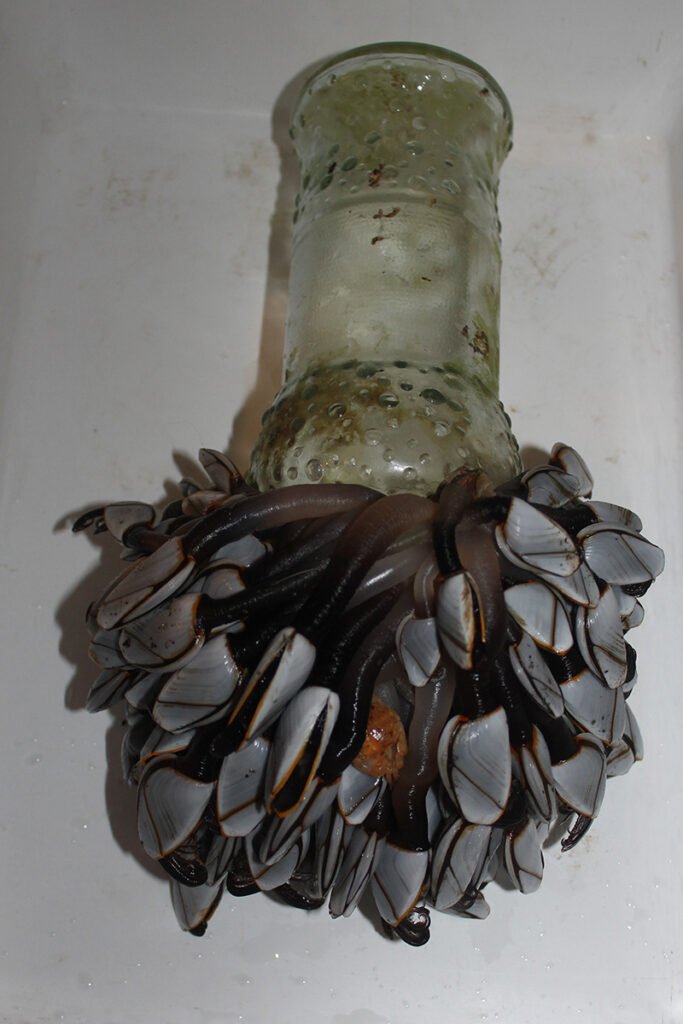
Here’s what we know of this little beauty today.
- Columbus crabs colour changes (albeit quite slowly) to suit whatever they are living on. This may be floating weed, goose barnacles, wood, even turtles. They’re chameleon crabs!
- They are considered to be tropical, arriving on our beaches in autumn and winter storms. But it is possible that they are partially adapted to take advantage of circulating ocean currents, So these currents take them all round the north Atlantic, unless they are unlucky enough to blow ashore or into the Arctic. The gulf stream which carries Columbus crabs towards our coast, splits on the edge of the continental shelf and curls back towards the Caribbean as the North Equatorial current ,potentially taking Columbus crabs home. I hope this does happen… cyclic crabs?
- Columbus crabs were considered to be rare finds in the early 2000s. According to Wikipedia the first British record is from Falmouth in 1845. We found our first in 2016. This may be a sign of climate change or it may be more people beach combing or looking for them. Possibly their predators and species which eat goose barnacles have become scarcer leading to more Columbine arrivals? …Collectable crabs
- Their arrival here, ashore, is a stranding, a tragedy really as they have no hope of survival. But it is a rare opportunity to find a crab of the graspid family arriving in Britain naturally. Anyone beach combing or rock pooling in the Mediterranean will be familiar with the pretty little green Mediterranean crabs (Brachynotus sexdentatus) which scuttle into hiding the moment they see you. They are also graspids, as are the invasive Chinese mitten crabs (Eriocheir sinensis) which are now established in some British rivers… cosmopolitan crabs.
- One of the few truly pelagic crabs, Columbus crabs live afloat and are able to swim for about half an hour before running out of energy when they sink rather than float… cruising crabs
Discovering crabs
The Columbus crab features in our new crabs colouring book alongside 12 other crabs you may encounter around the British coast.

It’s a great introduction to these fabulous crustaceans.


